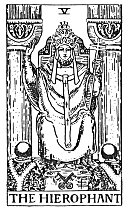
General Book of the Tarot, by A. E. Thierens, [1930], at sacred-texts.com
The fifth step on the cosmic ladder is that of the Atma, the Spark in macrocosmos and that of childbirth and of the heart in particular on the physical plane. The latter is sanctified by the former and this fact is symbolised in the image of the Hierophant.
[paragraph continues] It may also be interpreted in its turn as the sanctifying of the profane (man) by the holy (man) in general, and this fact gave the reason for the other nomination of this card: the pope. Of course it may equally well be called the patriarch. In the masonic lodge it is the R.W.M., the sun in the solar system and the heart in every living body, as also the solar plexus in the etheric body. And as the teaching of St. Paul--and others--has it: from the heart are the issues into life. It is the dynamic centre of every living existence.
The Hierophant "is seated between the two pillars of Hermes and of Solomon" . . . "He is symbol of mercy and beneficence." (M.) This is exact. P. says he is the principle "which attaches the material body to the divine spirit." Which is precisely that of the heart. So there remains little doubt with regard to identity. The same author identifies further the principle of the Hierophant with the Hebrew letter He, which means aspiration or breath. In fact the heart is the cause of this periodical movement, which we find in pulsation and respiration, in analogy with the Law of Periodicity in Cosmos.
In the different versions given by authors there is very little of value. The Hierophant is, in short; the heart and herein resides the motoric force for good or for evil, according to the more or less sanctifying force that comes through. In case of affliction there may be lack of courage, self-confidence, honesty, sometimes certain evil or bad character.
It is rightly asserted, that this card may denote "the man to whom the querent has recourse" (W.), also some authority or official having power to sanctify or gratify demands. Leo is the 'king,' it is said
by astrologers. And in mundane evolution the king derived his power from the emperor, as in the zodiac. He was invested by the latter with a power to wield and rule a definite and concrete organisation, for which he became individually responsible. So where the emperor was chosen and came forth from the soul of the people and apparently from below, the king is appointed from above, and seems more spiritual because more actually known. There ought to be no kings, however, without an emperor over them. The king is and remains the central official, as the heart is the central organ of the organism.
The triple crown of the Hierophant and his triple crossed staff both indicate his rulership in the three worlds, which I should like to name the spiritual, the psychical and the physical.
Some say the card means marriage. This may be, but only in the inner sense of true revelation to the heart, and consequently in the same sense as Jesus meant when He said: "Marriages are contracted in Heaven."
In another way, in practical divination, the card means of course 'sanction,' be it of marriage or of something else, but always in the way of inner consent, not of outer law, which is ruled by another house.
Self-centredness and some sort of natural authority are the chief characteristics of Leo and the Hierophant.